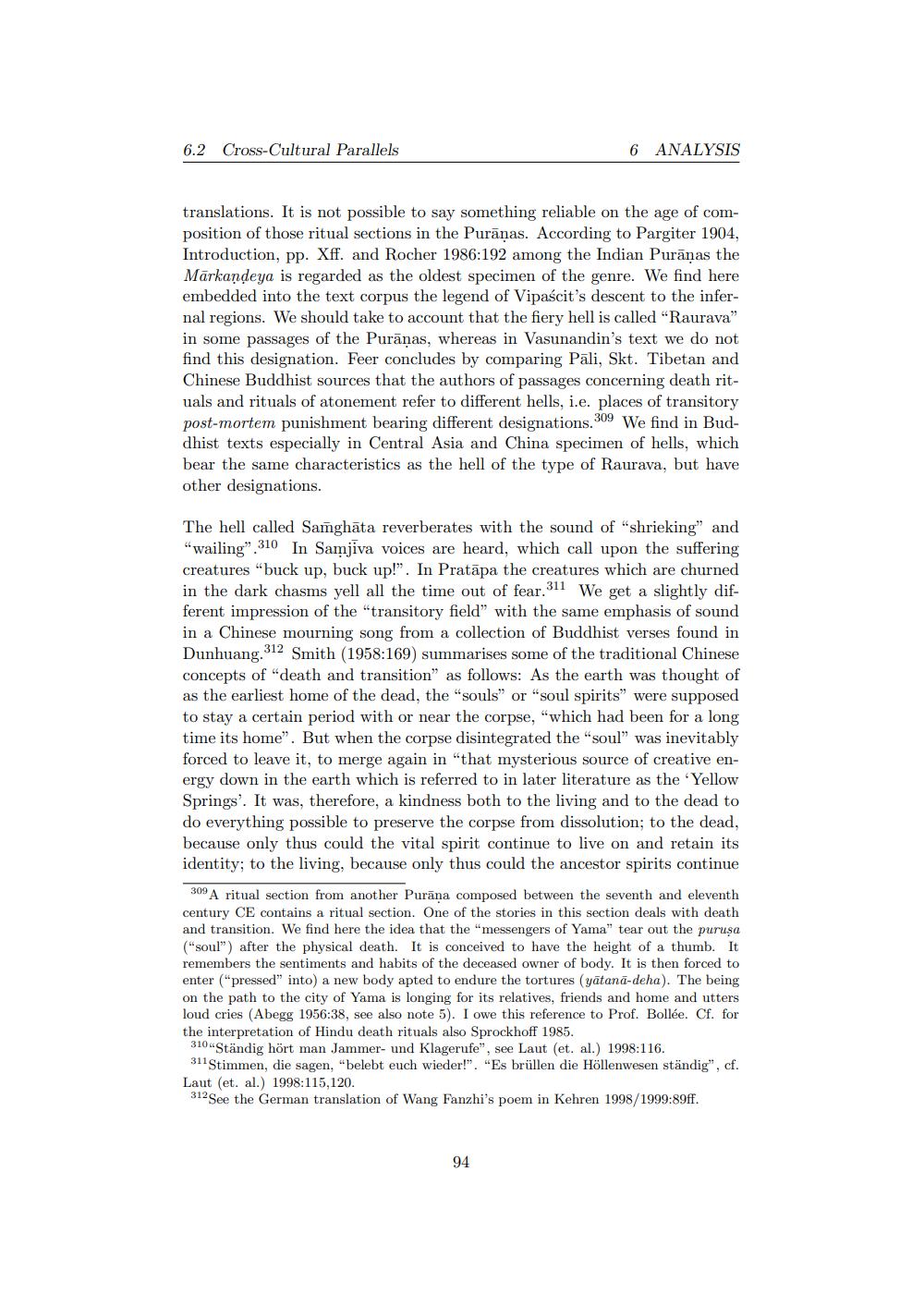________________
6.2
Cross-Cultural Parallels
6 ANALYSIS
translations. It is not possible to say something reliable on the age of composition of those ritual sections in the Purānas. According to Pargiter 1904, Introduction, pp. Xff. and Rocher 1986:192 among the Indian Puranas the Markandeya is regarded as the oldest specimen of the genre. We find here embedded into the text corpus the legend of Vipascit's descent to the infernal regions. We should take to account that the fiery hell is called "Raurava" in some passages of the Purānas, whereas in Vasunandin's text we do not find this designation. Feer concludes by comparing Pāli, Skt. Tibetan and Chinese Buddhist sources that the authors of passages concerning death rituals and rituals of atonement refer to different hells, i.e. places of transitory post-mortem punishment bearing different designations.309 We find in Buddhist texts especially in Central Asia and China specimen of hells, which bear the same characteristics as the hell of the type of Raurava, but have other designations.
The hell called Samghāta reverberates with the sound of "shrieking" and "wailing" 310 In Samjiva voices are heard, which call upon the suffering creatures "buck up, buck up!". In Pratāpa the creatures which are churned in the dark chasms yell all the time out of fear.311 We get a slightly different impression of the "transitory field" with the same emphasis of sound in a Chinese mourning song from a collection of Buddhist verses found in Dunhuang 312 Smith (1958:169) summarises some of the traditional Chinese concepts of "death and transition" as follows: As the earth was thought of as the earliest home of the dead, the "souls" or "soul spirits" were supposed to stay a certain period with or near the corpse, "which had been for a long time its home". But when the corpse disintegrated the "soul" was inevitably forced to leave it, to merge again in that mysterious source of creative energy down in the earth which is referred to in later literature as the 'Yellow Springs'. It was, therefore, a kindness both to the living and to the dead to do everything possible to preserve the corpse from dissolution; to the dead, because only thus could the vital spirit continue to live on and retain its identity; to the living, because only thus could the ancestor spirits continue
309 A ritual section from another Purāna composed between the seventh and eleventh century CE contains a ritual section. One of the stories in this section deals with death and transition. We find here the idea that the messengers of Yama" tear out the purusa ("soul") after the physical death. It is conceived to have the height of a thumb. It remembers the sentiments and habits of the deceased owner of body. It is then forced to enter ("pressed" into) a new body apted to endure the tortures (yātana-deha). The being on the path to the city of Yama is longing for its relatives, friends and home and utters loud cries (Abegg 1956:38, see also note 5). I owe this reference to Prof. Bollée. Cf. for the interpretation of Hindu death rituals also Sprockhoff 1985. 310 «Ständig hört man Jammer- und Klagerufe", see Laut (et. al.) 1998:116. 311 Stimmen, die sagen, "belebt euch wieder!". "Es brüllen die Höllenwesen ständig", cf. Laut (et. al.) 1998:115,120. 312 See the German translation of Wang Fanzhi's poem in Kehren 1998/1999:89ff.
94




